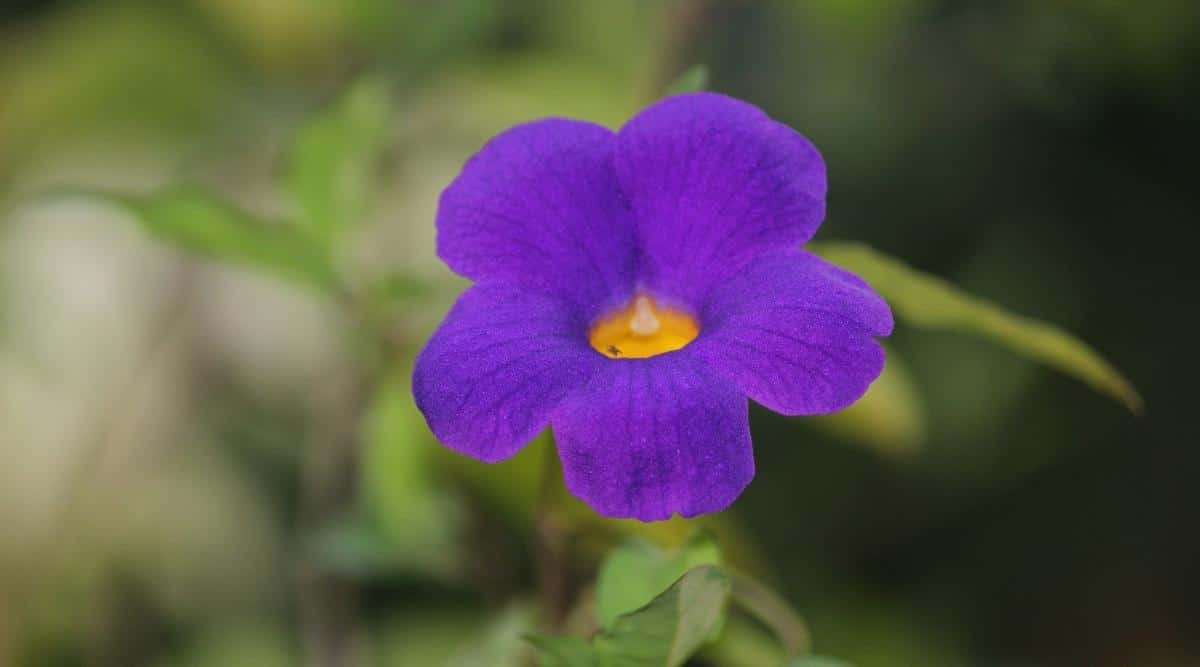jacksondwj.com – The King’s Mantle (Thunbergia erecta), also known as the Bush Clockvine or the Blue Trumpet Vine, is an attractive flowering plant renowned for its vibrant colors and fast-growing nature. Native to tropical Africa, this perennial is valued for its bold, striking blooms and lush foliage. Whether used as a shrub or trained as a climber, the King’s Mantle can add a touch of elegance and vibrant color to gardens in warmer climates.
Appearance and Characteristics
The King’s Mantle features large, trumpet-shaped flowers that typically come in shades of blue, purple, and occasionally white. The flowers have dark throats and a slightly tubular shape, creating a striking contrast between the petals and the interior of the bloom. The plant’s flowers are produced in clusters at the tips of its branches, making for a stunning visual display during the blooming season, which generally occurs in late spring and summer.
In addition to its eye-catching flowers, the King’s Mantle has lush, dark green leaves that form a dense, bushy shrub. The leaves are oval-shaped and glossy, offering a perfect backdrop for the bright blooms. The plant itself can grow to a height of 3 to 6 feet, depending on the growing conditions, and can spread 4 to 5 feet wide. It has a compact, well-rounded form, but when trained on a trellis or fence, it can also serve as an attractive climbing vine.
Growing Conditions
The King’s Mantle is best suited for tropical and subtropical climates where temperatures are consistently warm. It thrives in regions with USDA hardiness zones 9 to 11, but it can also be grown in containers and brought indoors in cooler climates. This plant loves the sun and prefers full sunlight or partial shade for optimal growth and flowering.
It is important to note that the King’s Mantle is a tropical plant that requires moderate to high humidity to grow well. It thrives in well-draining, loamy or sandy soils that retain moisture but don’t become soggy. While the plant is somewhat drought-tolerant once established, it will benefit from regular watering, especially during hot and dry periods. Proper drainage is essential to prevent root rot.
Care and Maintenance
King’s Mantle is a relatively low-maintenance plant that is easy to grow in the right conditions. However, there are a few key factors to keep in mind for optimal growth:
- Watering: Ensure the plant receives regular water, particularly during dry spells. While it is drought-tolerant once established, consistent moisture helps maintain vibrant blooms. Be sure the soil is well-draining to avoid waterlogging.
- Light: Full sun is ideal for King’s Mantle, but it can tolerate some light shade, especially in regions with extremely hot summers. In shaded areas, flowering may be reduced, but the plant will still grow.
- Soil: Plant King’s Mantle in rich, well-drained soil that retains some moisture. Sandy or loamy soils are ideal, but avoid heavy clay that can retain too much water.
- Fertilizing: King’s Mantle benefits from occasional feeding with a balanced, water-soluble fertilizer. Apply during the growing season to promote healthy growth and abundant blooms. However, over-fertilizing can lead to excessive foliage growth at the expense of flowers.
- Pruning: Regular pruning helps to shape the plant and encourage bushier growth. After flowering, trim back any dead or damaged branches to maintain a tidy appearance. If the plant is grown as a climber, prune to control its spread and prevent it from becoming too unruly.
- Pests and Diseases: King’s Mantle is relatively pest-resistant but may occasionally suffer from aphids, spider mites, or fungal issues in humid conditions. Keep an eye out for pests and treat with appropriate insecticidal soap or neem oil as needed.
Attracting Pollinators
The vibrant flowers of the King’s Mantle are a favorite among pollinators. Bees, butterflies, and hummingbirds are often seen visiting the blooms, collecting nectar. Its ability to attract these pollinators makes it an excellent addition to a garden designed to support local wildlife. The plant’s dense foliage also offers a habitat for small birds and insects, further enhancing the biodiversity of the garden.
King’s Mantle in the Landscape
The King’s Mantle is a versatile plant that can be used in a variety of garden designs. When grown as a shrub, it works well in flower beds or as a border plant, providing a splash of color during its blooming season. Its compact size makes it perfect for smaller gardens or as part of a mixed shrub border.
For a more dramatic effect, the King’s Mantle can be trained to climb on trellises, fences, or arbors. This allows the plant to showcase its flowers in vertical spaces, where they can be admired up close. It’s also a great plant for hanging baskets or large containers, where it can spill over the edges in a cascade of color.
The King’s Mantle is particularly suited to tropical or Mediterranean-style gardens, where its vibrant flowers can complement other bold, sun-loving plants. It also makes a great addition to cottage gardens or butterfly gardens, where its pollinator-friendly nature supports biodiversity.
Conclusion
The King’s Mantle is a stunning and versatile flowering plant that can add both beauty and function to any garden. With its large, trumpet-shaped flowers, glossy green foliage, and easy-to-care-for nature, it’s a great choice for both beginner and experienced gardeners. Whether used as a shrub, climbing vine, or container plant, the King’s Mantle brings vibrant color and attracts pollinators to the landscape. Its ability to thrive in warm, sunny climates and its low-maintenance care make it an excellent addition to gardens looking for a touch of tropical elegance.
